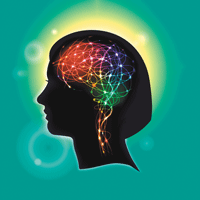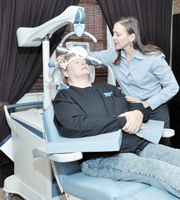Can brain stimulation aid memory and brain health?
Can brain stimulation aid memory and brain health?
 Image: Thinkstock Image: Thinkstock |
The jury is still out, but magnetic fields or mild electric currents may aid learning and help several conditions that affect women in particular.
Stimulating your brain doesn’t just mean spending an evening at the theater or reading a good book. These days it can involve sitting with your head against a magnet or wearing electrodes that transmit a low-voltage current through your scalp to activate—or suppress—certain neurons in your brain. The prospect of regulating brain signals responsible for mood, pain, and learning is so compelling that scores of studies are under way to see if, and how, the approach can be used to sharpen mental skills and treat symptoms of several mind-body disorders. “Brain stimulation, if used carefully and safely, looks promising, especially if combined with other therapies,” says Dr. Daniel Press, a neurologist with the Berenson-Allen Center for Noninvasive Brain Stimulation at Harvard-affiliated Beth Israel Deaconess Medical Center. Dr. Press has used noninvasive brain stimulation for almost a decade.
How do the devices work?
Two types of brain stimulation are available today. Each has FDA clearance for at least one medical purpose but is being used in clinical trials and “off label” to treat several medical conditions.
|
In TMS therapy, the physician positions the magnet to stimulate neurons in a specific area of the brain that is underactive in people with |
Transcranial magnetic stimulation (TMS) uses a magnetic field generated by a coil in a paddle that is held against the patient’s head to stimulate specific areas of the brain. This form of therapy is also called repetitive TMS or rTMS because the magnet is turned on and off rapidly, creating an effect that feels as though someone is tapping on your head. The magnet emits loud noises as it is turned on and off, which requires people undergoing TMS therapy to wear earplugs during the 40-minute sessions. Side effects are usually limited to headaches and ringing in the ears.
Transcranial direct current stimulation (tDCS) transmits a weak current from a 9-volt battery (the size used in a smoke detector) through electrodes on the forehead or scalp. People who undergo tDCS may feel their scalp tingle and hear a humming noise. Each session lasts about 20 minutes.
Both TMS and tDCS are being used to treat the following:
Depression. TMS stimulates neurons in the prefrontal cortex, a region of the brain that is underactive in people with depression. TMS received FDA clearance in 2008 for treating people with depression for whom drugs haven’t been effective. It may also be an alternative for women with depression who are pregnant or breastfeeding and thus may not want to take antidepressants. Unlike electro-convulsive therapy, which is also approved for depression that isn’t alleviated by medication, TMS isn’t likely to cause seizures or memory loss. Insurance may cover TMS therapy.
TDCS, which is FDA-cleared only to speed the absorption of certain medications through the skin, is also being used to treat depression. Because tDCS is still considered experimental, insurance won’t pay for this therapy for depression or any other condition.
Chronic pain. In a recent review of several randomized controlled clinical trials of TMS, Harvard re-searchers concluded that it was effective in treating nerve pain, including back and leg pain, pain and numbness in hands and feet caused by diabetes, and fibromyalgia. Although there are fewer data for tDCS, it may also be effective for those conditions.
Damage from stroke. Preliminary research suggests that TMS and tDCS may improve a person’s ability to move and speak and to overcome what’s called spatial neglect—the inability to notice or recognize objects on one side of the body. (Stroke damage on the right side of the brain affects the visual field on the left.)
Eating disorders. In early studies, both TMS and tDCS have reduced episodes of binge eating and bulimia in women with those eating disorders.
Migraine. A portable device that delivers a different type of TMS has received FDA clearance for treating migraine headache with aura (headache preceded by flashes of light, tingling, or other sensory disturbances). The manufacturer is conducting post-marketing studies at several headache centers before making it available by prescription.
Tinnitus. Researchers are exploring new ways to deliver TMS to reduce or eliminate the perception of ringing in the ears or other sounds within the head.
Memory and learning. In the last few years there have been scores of studies evaluating the effect of TMS or tDCS on people’s ability to perform mental tasks, particularly those that involve discerning visual patterns, re-calling lists of unrelated words, or doing math problems. Over all, the results indicate that the techniques are most likely to improve mental function when used in conjunction with other types of training, such as learning new systems for remembering names. A few small studies in people with mild Alzheimer’s disease suggest that TMS could be combined with cognitive exercises to improve function.
If you’re interested in noninvasive brain stimulation
You can locate the nearest medical facility that offers TMS to treat depression by going to the website of NeuroStar, the TMS system with FDA clearance for treating depression (www.neurostar.com), and entering your ZIP code. The best way to get TMS or tDCS therapy for other medical conditions or to improve cognitive function is to enroll in one of the scores of clinical trials seeking volunteers. To find one in your area, go to the study database maintained by the National Institutes of Health at www.clinicaltrials.gov.
Can brain stimulation aid memory and brain health?的更多相关文章
- L308 New brain cells made throughout life
People keep making new brain cells throughout their lives (well at least until the age of 97), accor ...
- Memory loss【记忆缺失】
Memory Loss Losing your ability to think and remember is pretty scary. We know the risk of dementia ...
- EEG: electrode positions & Broadmann atlas
Source: http://www.brainm.com/software/pubs/dg/BA_10-20_ROI_Talairach/nearesteeg.htm Area LEFT RIG ...
- CET4
Directions: For this part, you are allowed 30 minutes to write a short essay on the challenges of st ...
- 26 Time Management(转)
01. There is alway time. Time is priorities. 时间常有.时间优先. 02. Days always fill up. 时间总会有的. Only plan f ...
- (转)Let’s make a DQN 系列
Let's make a DQN 系列 Let's make a DQN: Theory September 27, 2016DQN This article is part of series Le ...
- ADNI以及study design简介
相关名词: MCI:轻度认知功能障碍 EMCI:早期认知障碍 MCI:轻度认知障碍 LMCI:晚期认知障碍 CN:认知正常的志愿者 DTI:doppler tissue imaging,多普勒组织显像 ...
- 英语每日阅读---8、VOA慢速英语(翻译+字幕+讲解):脸肓症患者记不住别人的脸
英语每日阅读---8.VOA慢速英语(翻译+字幕+讲解):脸肓症患者记不住别人的脸 一.总结 一句话总结: a.neural abnormalities are more widespread:Duc ...
- [C3] Andrew Ng - Neural Networks and Deep Learning
About this Course If you want to break into cutting-edge AI, this course will help you do so. Deep l ...
随机推荐
- jQ的toggle()方法示例
定义和用法toggle() 方法切换元素的可见状态.如果被选元素可见,则隐藏这些元素,如果被选元素隐藏,则显示这些元素. 语法$(selector).toggle(speed,callback,swi ...
- bzoj2012: [Ceoi2010]Pin
Description 给出N(2<=N<=50000)个长度为4的字符串,问有且仅有D(1<=D<=4)处不相同的字符串有几对. Input 第1行: N,D 以下N行每行一 ...
- Hadoop:使用Mrjob框架编写MapReduce
Mrjob简介 Mrjob是一个编写MapReduce任务的开源Python框架,它实际上对Hadoop Streaming的命令行进行了封装,因此接粗不到Hadoop的数据流命令行,使我们可以更轻松 ...
- 2015年8月TIOBE编程语言排行榜
名副其实的月经贴.
- rabbitmq例子
安装 sudo apt-get install rabbitmq-server 开启后台管理 sudo rabbitmq-plugins enable rabbitmq_management;sudo ...
- HDU2490 parade
题目大意:一个n+1行m+1列的表格,每个格子两个数w和c,表示经过该格子的happy和体力消耗值tireness.现在从最下面任意处开始,可以向左向右向上走.但不能向下.每个格子不能经过两次.在每一 ...
- Qt属性表控件的使用 QtTreePropertyBrowser
属性表是vs2003时引入的的新控件,用于流量和设置大量的信息,现在,很多软件上都能看到它的身影,如vs,Qt Creator等IDE的详细设置里都离不开属性表. 下图是Qt Creator里的属性表 ...
- 使用BlockingQueue的生产者消费者模式
BlockingQueue很好的解决了多线程中,如何高效安全“传输”数据的问题.通过这些高效并且线程安全的队列类,为我们快速搭建高质量的多线程程序带来极大的便利.使用场景. 首先它是一个队列,而一个队 ...
- JDK1.7新特性
jdk1.7新特性 1 对集合类的语言支持: 2 自动资源管理: 3 改进的通用实例创建类型推断: 4 数字字面量下划线支持: 5 switch中使用string: 6 二进制字面量: 7 简化可变参 ...
- WLS_Oracle Weblogic安装和环境搭建(案例)
2014-01-03 Created By BaoXinjian

